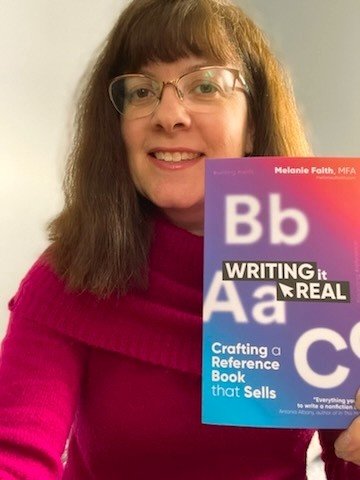By: Melanie Faith
What does cooking and writing have in common? A richness of inviting language.
Think about the sheer number of words to describe something “delicious,” for instance. From “decadent” to “delectable” to “delightful” to “exquisite” and “appetizing” and “tasty” and “flavorful” and even “mouthwatering,” each word underscores a very particular quality about the dish.
Speaking of which, even the word “dish” has numerous shades of meaning, tones, and definitions that can lead to descriptive and delightful writing. From the cooking containers to the food itself to an attractive person to giving a friend the scoop by sharing gossip to punishing, as in “you can dish it out but you can’t take it,” the variety of descriptors, contexts, and diction choices make the pairing of writing and nourishment a natural fit. Much like ice cream and the waffle cone that conveys it, they can be a great symbiotic duo.
· Food writing has ample diction options. Our descriptions of the foods we stir, spoon, swirl, chew, or slurp tend to be precise and as varied as the salad of verbs we can choose from to denote how we compose or eat our meals and certainly how we feel or felt about them and/or the people who made them. One of the reasons writing about food is so fun is that there are endless words that bring our passion, distaste, or other emotions about making or eating food to vibrant life on the page.
· Food writing has point of view. Some types of writing are easier than others to denote a clear and strong point of view. Food writing tends to have a very focused and clear POV. For instance, people tend to have complicated relationships with certain foods, such as durian fruit or sauerkraut, and it’s often easy to spot the point of view and tone of the author—whether like, love, confusion, or loathing—often in the first few sentences.
· Food writing has theme. One of my favorite qualities about food writing is that however much the focus is on creating or imbibing or not relishing some eating experiences, it’s never ONLY about the foods at all. Much food writing is rich in setting, imagery, and contextual details that tell the readers something deeper about the speaker’s life or the characters’ lives. Food writing covers a dynamic array of topics, from cultural celebrations and birth stories to addiction, divorce, office romances, first jobs and first apartments, and you name it. Food is present at just about every turning point in our lives, so when writing about food we are presented with endless possibilities, not only for what dishes have meant in our lives in the past but also now and what it might mean in the future. Personal essays, recipes, chapbooks of stories or essays, and/or characters describing foods for children and grandchildren are all food writing. Just about any topic or theme you can imagine from your everyday life will have at least one ingredient, dish, meal, holiday recipe, or family barbecue/picnic/party or road trip associated with it that could make vivid and meaningful prose or poetry.
· Food writing is not genre restricted. We often think immediately of recipe books or cooking shows when we think of food writing, both of which are kinds of food writing, but that is just the very, very, very tip of the food-writing iceberg. Poems are also food writing. One-act plays with a dinner scene, also food writing. Restaurant reviews, too—food writing. Flash fiction and flash memoir and hybrid pieces, all food writing. Guess what: so are jokes, comedic essays, scenes from novels or novellas, and just about any other genre you can think of. If it has something about eating or being unable to eat, someone making something to eat and failing or succeeding at it, people congregating to eat, people rejecting what’s on the table to eat in favor of something else, the struggles of eating and cooking, people learning to cook, and so on, then it’s food writing. Period. The vast variety of food writing makes for especially fun writing and reading experiences.
Considering the rich themes, descriptive language, focused point of view, and genre possibilities, food writing is one of the most exciting writing experiences an author can have. Like a meal to savor, food writing invites a writer’s imagination, memories, and talents to the table, month after month, year after year.
***
My Food Writing class begins on Friday, April 8th. I’d love to have you and a friend join me for this delectable and fun class. Click for more details and the sign-up link.











